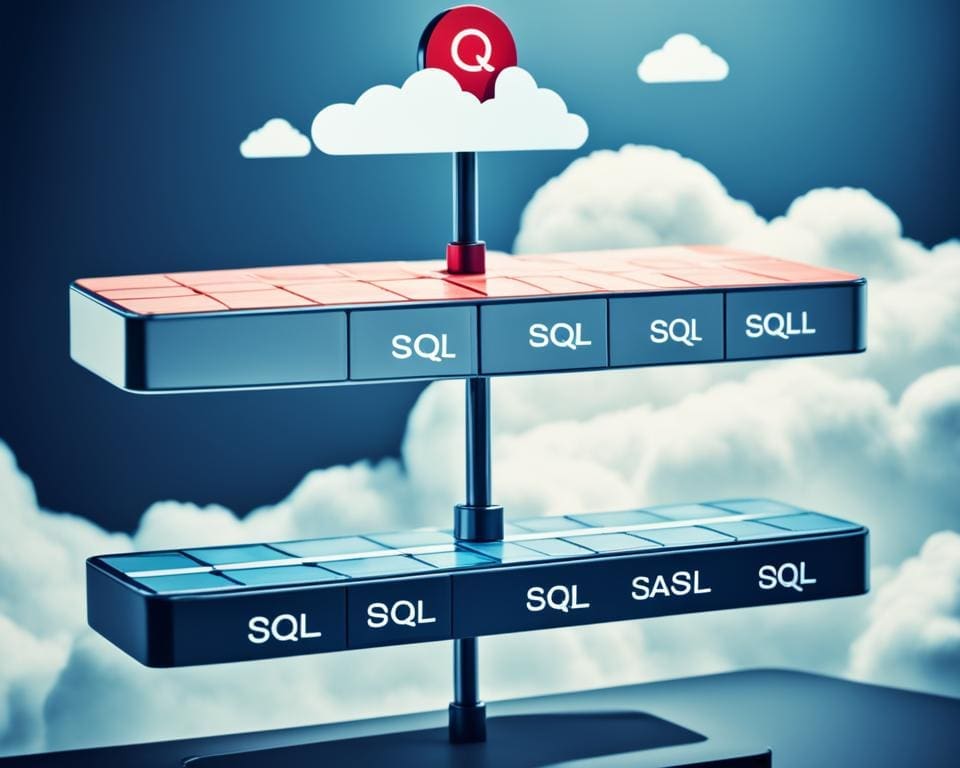In today’s world, Choosing Between SQL and NoSQL Databases is vital. SQL databases work well for structured data, offering vertical scalability. NoSQL databases offer flexibility for unstructured data.
To keep up with different data types, knowing the differences between SQL and NoSQL is key. SQL databases are great for exact transactions. NoSQL can handle large datasets efficiently.
This piece will help you understand SQL vs NoSQL. It will give you the necessary tools to make informed decisions.
Understanding SQL Databases
For over 40 years, Structured Query Language (SQL) has been key in managing databases. An Overview of SQL shows its role in dealing with structured data. It uses relational databases, organizing data into tables. This method ensures data integrity and efficient management. Hence, SQL databases are widely preferred.
Overview of SQL
SQL is made for managing data in relational database systems. It helps users to query, update, and retrieve data. A predefined schema is used in SQL databases. This means the data follows a certain structure. This method is effective and has strong community support.
Features of SQL Databases
The Features of SQL Databases are:
- Relational Architecture: Setting up and managing data relationships is straightforward.
- Vertical Scalability: SQL databases scale up well by boosting hardware.
- Strong Consistency Models: They ensure data integrity with ACID properties.
- Established Vendor Support: Big names like Microsoft and Oracle provide great support.
Popular SQL Database Systems
Several SQL databases stand out for their features and uses. For instance:
- MySQL: Known for good performance, perfect for web apps.
- Microsoft SQL Server: It has versions for different needs, with cloud options via Microsoft Azure.
- Oracle Database: A veteran RDBMS, it’s growing into a versatile system with special SQL features.
- PostgreSQL: It’s known for handling complex queries well and being standards-compliant.

Choosing Between SQL and NoSQL Databases
Choosing the right database—SQL or NoSQL—is crucial for your project. It affects how you manage data and your application’s performance. Make sure your choice matches your project’s requirements.
Key Differences
SQL databases are organised in tables, with clear data relationships. They grow by upgrading their hardware, like adding more RAM. Complex queries and strong data integrity prefer SQL.
NoSQL databases use different data models, like documents or graphs. They expand by adding more servers. This is good for handling big, changing datasets.
- SQL databases employ Structured Query Language (SQL) for data manipulation.
- NoSQL databases utilise diverse query languages based on their data model.
- Examples of popular SQL databases include MySQL, PostgreSQL, and Oracle Database.
- NoSQL counterparts like MongoDB, Cassandra, and HBase specialise in handling varied data forms.
SQL databases follow ACID rules, ensuring strong transaction integrity. NoSQL prefers the CAP theorem, which fits cloud setups better.
When to Use SQL
Deciding on SQL or NoSQL depends on your project’s needs. Use SQL for complex, high-integrity transactions. It’s perfect for financial systems or those needing strict consistency.
Choose SQL when your data is stable and structured. SQL’s broad community support makes it attractive for many projects.
NoSQL Database Fundamentals
NoSQL has changed how we handle data, offering a flexible approach. It’s essential for organisations to understand NoSQL. This knowledge helps them manage their data better in today’s varied data scene. NoSQL does not use a fixed structure like SQL databases do. Instead, it allows for different data types and structures.
What is NoSQL?
NoSQL stands for a variety of database technologies that deal with unstructured or semi-structured data. These databases can store many data models. They are great for applications that need to grow and change quickly. This makes it easier for organisations to keep up with fast changes in data needs.
Advantages of NoSQL
The upsides of NoSQL are many and make it better than old SQL systems in some ways. Some benefits are:
- Horizontal Scalability: You can manage more data by adding servers with NoSQL, rather than upgrading to bigger ones.
- Performance: NoSQL is made for fast use across many locations, perfect for quick data access and changes.
- Diverse Data Handling: It fits today’s app needs by supporting various data formats, like documents, key-value stores, and graphs.
MongoDB is great for changing data needs, while Cassandra can deal with huge amounts of data. Knowing about NoSQL helps organisations get the most out of it when SQL databases can’t meet their needs for flexibility or growth.
Pros and Cons of SQL vs NoSQL
In the ongoing debate between SQL vs NoSQL, it’s vital to know their pros and cons. SQL databases have been around since the 1970s. They’re great for data accuracy and complex queries. Plus, they offer a strong structure for managing structured data, thanks to their ACID compliance. However, their fixed schema can be a drawback. This is especially true for vertical scaling and adjusting to new data types.
NoSQL databases, on the other hand, started in the 2000s. They’re built for large, spread-out datasets like Big Data. Their ability to handle unstructured data and scale horizontally is a big plus for modern web apps. But, they might sacrifice data integrity and consistency. This is because they lack a unified query language. This can lead to problems with complex queries. So, think carefully before choosing between SQL or NoSQL for your project.
The choice depends on your data, the kinds of queries you’ll run, and your scaling needs. SQL is the preferred option for structured and segmented data management. NoSQL is better for projects that require flexible storage solutions. By understanding the differences between SQL and NoSQL, you can pick the most suitable database. This will help you manage your data successfully and meet your project goals.









